Experimental Study on the Lateral Seepage Characteristics in the Tension Saturated Zone
Abstract
:1. Introduction
2. Materials and Methods
2.1. Experimental Apparatus
2.2. Experimental Conditions and Process
2.2.1. Experimental Conditions
2.2.2. Experimental Process
2.3. Data Processing
3. Results and Discussion
3.1. Water Flow Characteristics
3.2. Water Potential Distribution Features of the Seepage Field
3.2.1. Total Water Potential Distribution Features
3.2.2. Pressure Potential Distribution Features
3.3. Distribution Characteristics of the TSZ Thickness
3.4. Interfacial Characteristics of the TSZ
3.4.1. Characteristics of the Phreatic Surface and Upper Bound of the TSZ
3.4.2. Characteristics of the Lateral Boundary of the TSZ
3.4.3. Causes of the Lateral Seepage Characteristics
4. Conclusions
Author Contributions
Funding
Institutional Review Board Statement
Informed Consent Statement
Data Availability Statement
Conflicts of Interest
References
- Luthin, J.N.; Day, P.R. Lateral flow above a sloping water table. Soil Sci. Soc. Am. J. 1955, 19, 406–410. [Google Scholar] [CrossRef]
- Bear, J. Hydraulics of Groundwater; Dover Publications: Mineloa, NY, USA, 2012. [Google Scholar]
- Silliman, S.E.; Berkowitz, B.; Simunek, J.; van Genuchten, M.T. Fluid flow and solute migration within the capillary fringe. Groundwater 2002, 40, 76–84. [Google Scholar] [CrossRef] [PubMed]
- Taylor, M.D. Investigation of Flow within the Capillary Fringe Using a Synthetic Aquifer; The University of Arizona: Tucson, AZ, USA, 2001. [Google Scholar]
- van Stempvoort, D.R.; Kwong, Y.T.J. Sulfur analyses as tracers of microbial degradation of hydrocarbons in the capillary fringe. J. Contam. Hydrol. 2010, 114, 1–17. [Google Scholar] [CrossRef] [PubMed]
- Pojmark, P. Tracing Water Movement in the Capillary Fringe; Division of Water Resources Engineering: Skåne County, Sweden, 2011. [Google Scholar]
- Xu, Z. Suspended Water Hydrologic Geology Tract; Earthquake Publishing House: Beijing, China, 1993. (In Chinese) [Google Scholar]
- Freitas, J.G.; Barker, J.F. Monitoring lateral transport of ethanol and dissolved gasoline compounds in the capillary fringe. Groundw. Monit. Remediat. 2011, 31, 95–102. [Google Scholar] [CrossRef]
- Abit, S.M.; Amoozegar, A.; Vepraskas, M.J.; Niewoehner, C.P. Fate of nitrate in the capillary fringe and shallow groundwater in a drained sandy soil. Geoderma 2008, 146, 209–215. [Google Scholar] [CrossRef]
- Abit, S.M.; Amoozegar, A.; Vepraskas, M.J.; Niewoehner, C.P. Soil and hydrologic effects on fate and horizontal transport in the capillary fringe of surface-applied nitrate. Geoderma 2012, 189, 343–350. [Google Scholar] [CrossRef]
- Mazdeh, A.M.; Wohnlich, S. Experimental study on velocity and flow patterns in the capillary fringe. Grundwasser 2019, 24, 65–72. [Google Scholar] [CrossRef]
- Ma, C.; He, Z.; Li, Q.; Zhang, H.; Liu, C. Experimental study on water seepage law in the tension saturated zone. J. Soils Sediments 2017, 17, 1644–1652. [Google Scholar] [CrossRef]
- Hubbert, M.K. The theory of ground-water motion. J. Geol. 1940, 48, 785–944. [Google Scholar] [CrossRef]
- Zhang, R.Q.; Liang, X.; Jin, M.G.; Wan, L.; Yu, Q.C. Fundamentals of Hydrogeology; Geological Publishing House: Beijing, China, 2011. (In Chinese) [Google Scholar]
- Guo, Z.; Cao, Y. Spontaneous liquid uplift in biliquid capillary siphons. Transp. Porous Media 2007, 67, 317–322. [Google Scholar] [CrossRef]
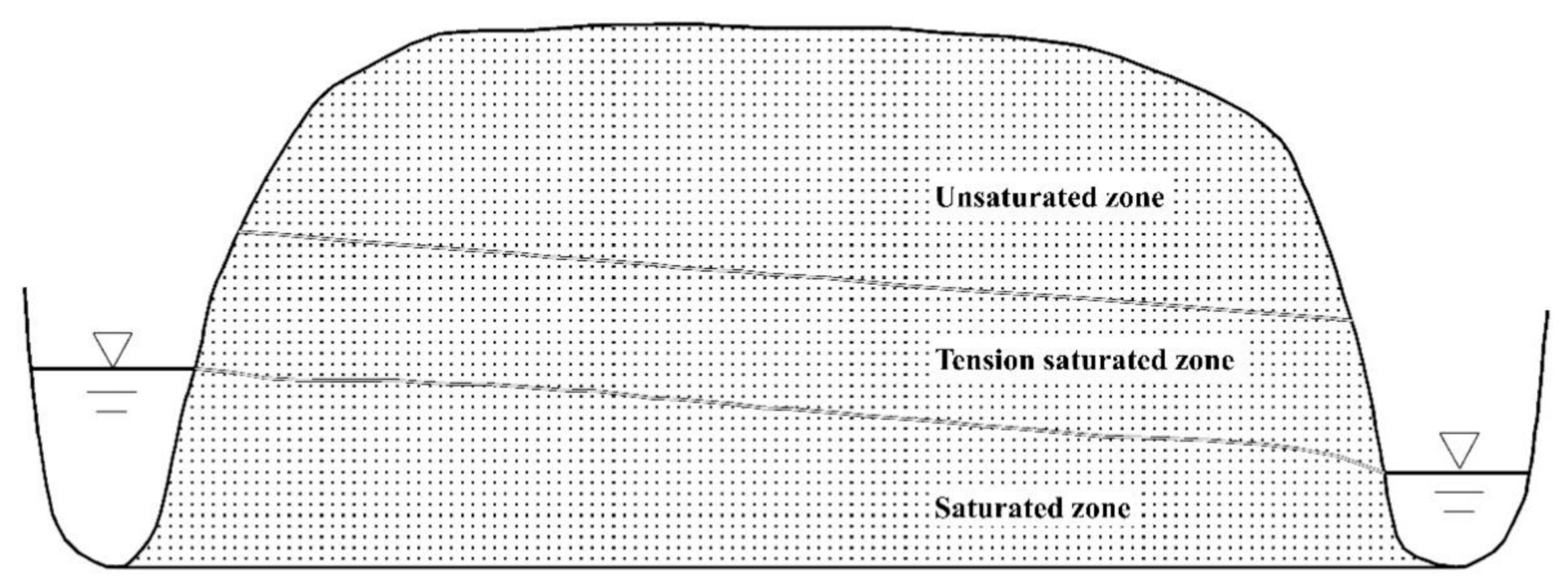
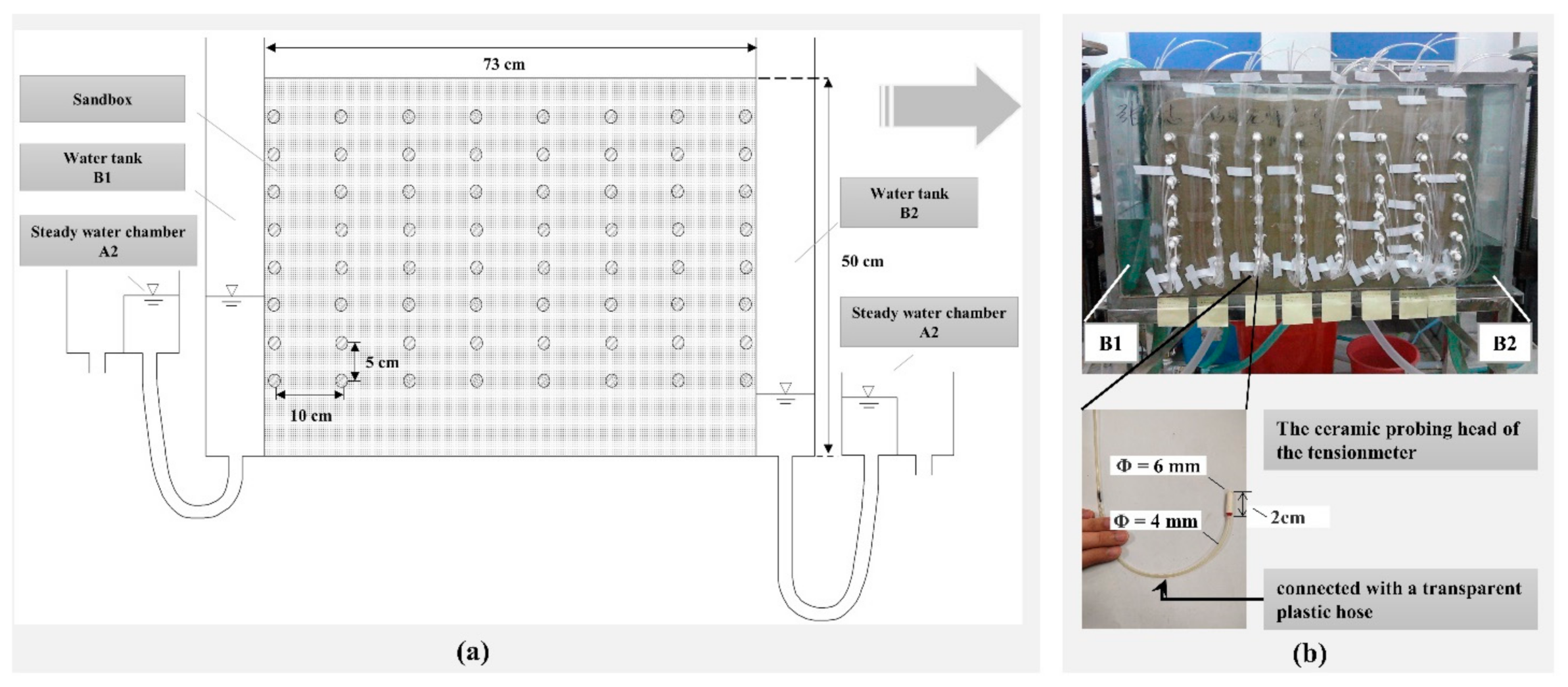
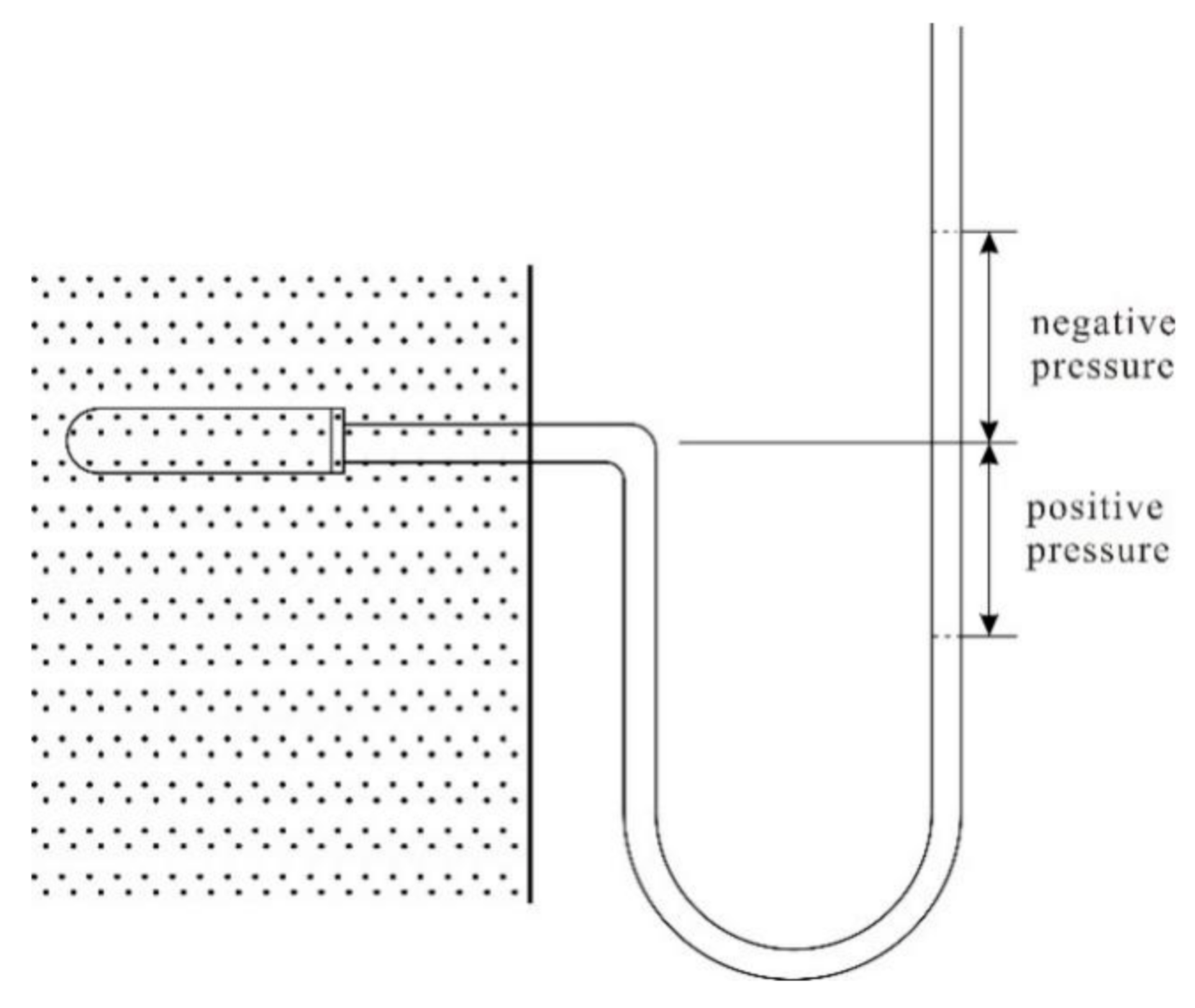


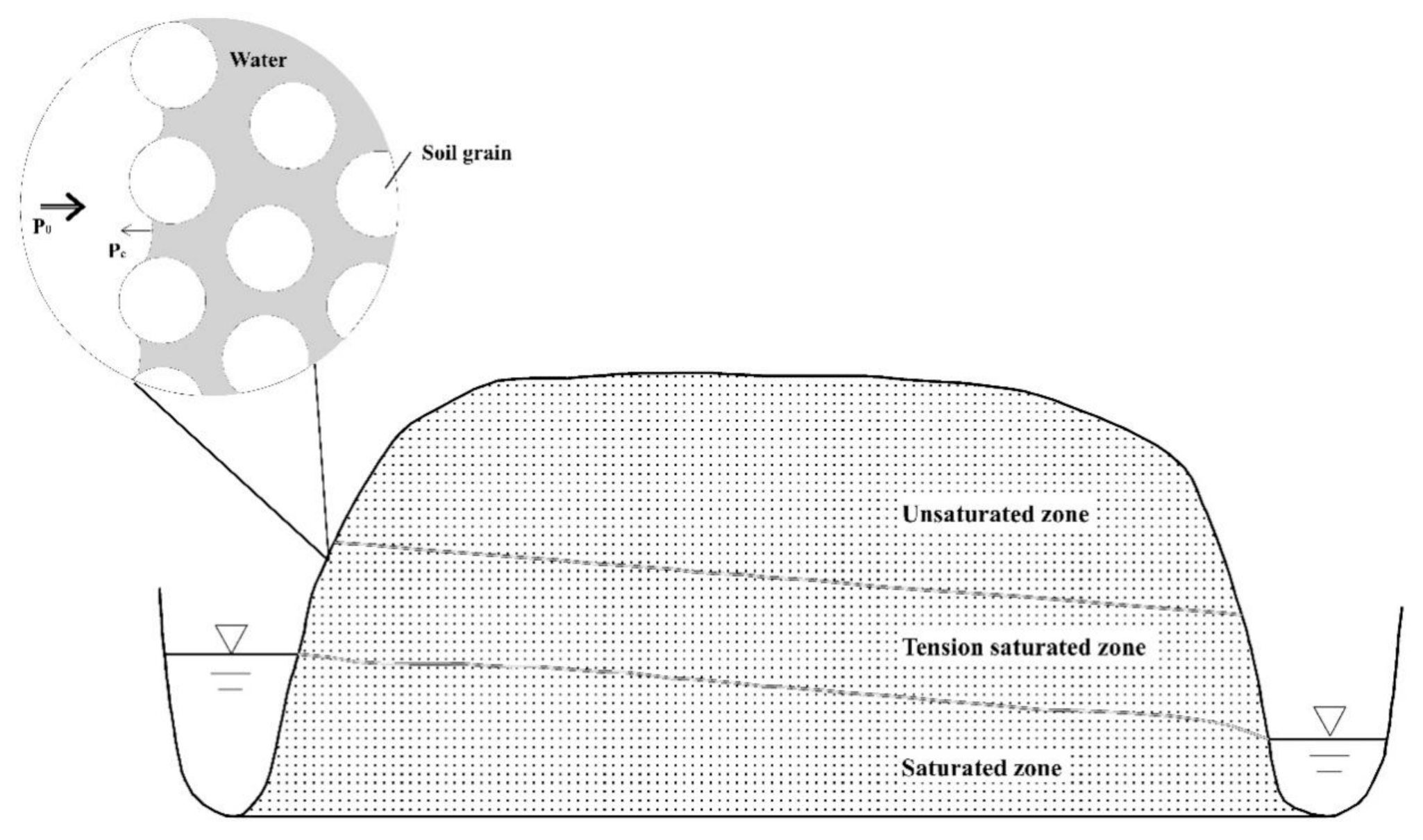
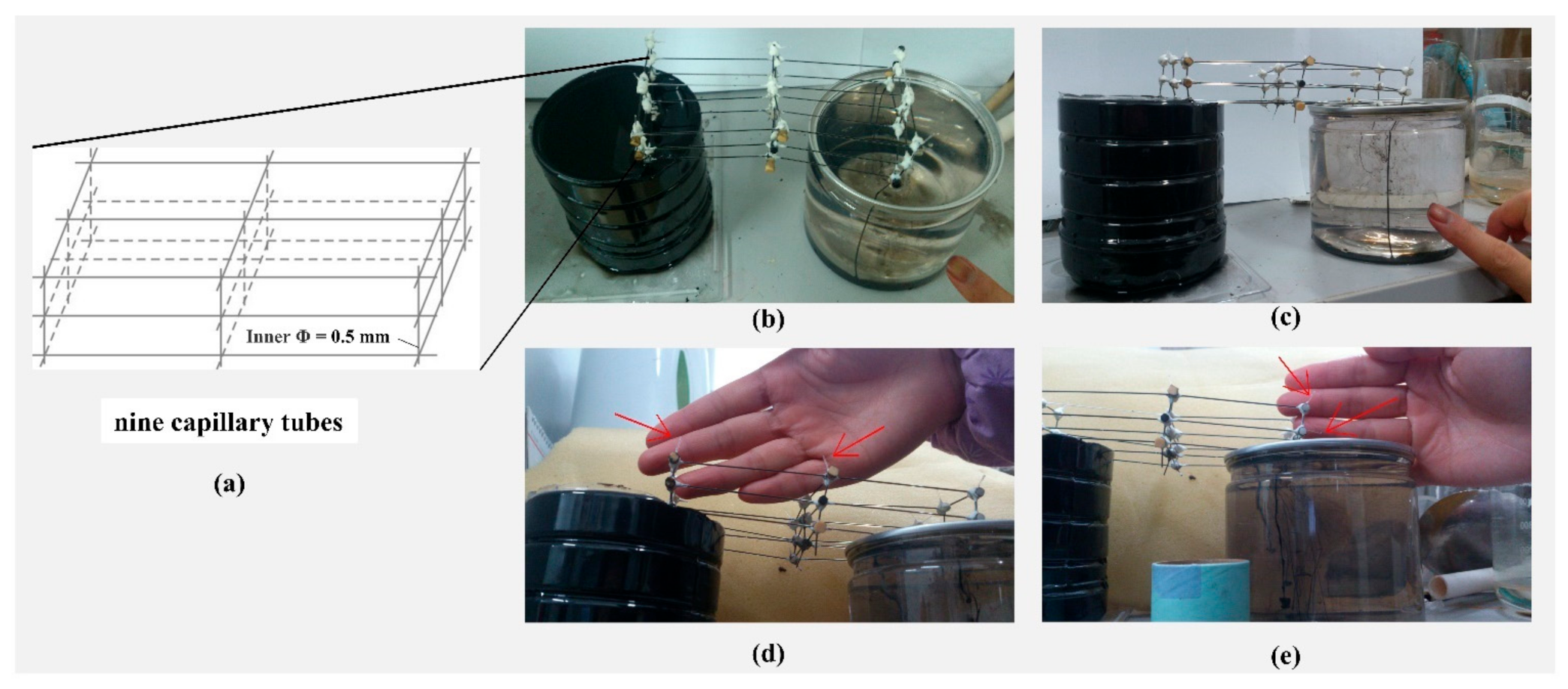
| Pressure Potential (Water Column: cm) | Ascending Area (e.g., Abscissa of 5 cm in x Axis) | Nearly Horizontal Flow Area (e.g., Abscissa of 30 cm in x Axis) | Descending Area (e.g., Abscissa of 65 cm in x Axis) |
|---|---|---|---|
| 0 to −8 (the upper part of TSZ) | 1.10 | 1.01 | 0.92 |
| −8 to −18 (the lower part of TSZ) | 1.07 | 0.99 | 0.97 |
| Vertical Distance above Water Table | Ascending Area (e.g., Abscissa of 5 cm in x Axis) | Central Nearly Horizontal Flow Area (e.g., Abscissa of 30 cm in x Axis) | Descending Area (e.g., Abscissa of 65 cm in x Axis) |
|---|---|---|---|
| 5 | −5.68 | −5.10 | −4.57 |
| 10 | −11.04 | −10.15 | −9.28 |
| 15 | −16.47 | −15.18 | −14.08 |
| Area | Ascending Area (e.g., Abscissa of 5 cm in x Axis) | Central Nearly Horizontal Flow Area (e.g., Abscissa of 30 cm in x Axis) | Descending Area (e.g., Abscissa of 65 cm in x Axis) |
|---|---|---|---|
| Measured value | 16.4 | 17.9 | 19.0 |
| Calculated value | 16.5 | 17.8 | 19.0 |
Publisher’s Note: MDPI stays neutral with regard to jurisdictional claims in published maps and institutional affiliations. |
© 2021 by the authors. Licensee MDPI, Basel, Switzerland. This article is an open access article distributed under the terms and conditions of the Creative Commons Attribution (CC BY) license (https://creativecommons.org/licenses/by/4.0/).
Share and Cite
Gong, Y.; Liu, Z.; Ma, C.; Li, M.; Guo, X. Experimental Study on the Lateral Seepage Characteristics in the Tension Saturated Zone. Int. J. Environ. Res. Public Health 2021, 18, 5098. https://doi.org/10.3390/ijerph18105098
Gong Y, Liu Z, Ma C, Li M, Guo X. Experimental Study on the Lateral Seepage Characteristics in the Tension Saturated Zone. International Journal of Environmental Research and Public Health. 2021; 18(10):5098. https://doi.org/10.3390/ijerph18105098
Chicago/Turabian StyleGong, Yongfeng, Zuo Liu, Chuanming Ma, Minghong Li, and Xu Guo. 2021. "Experimental Study on the Lateral Seepage Characteristics in the Tension Saturated Zone" International Journal of Environmental Research and Public Health 18, no. 10: 5098. https://doi.org/10.3390/ijerph18105098
APA StyleGong, Y., Liu, Z., Ma, C., Li, M., & Guo, X. (2021). Experimental Study on the Lateral Seepage Characteristics in the Tension Saturated Zone. International Journal of Environmental Research and Public Health, 18(10), 5098. https://doi.org/10.3390/ijerph18105098





